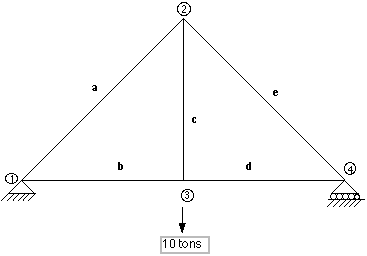
Deciding Which Structure Is Best
Your class can have a "hands-on experience" with building a strong structure. Start by having the students build two kinds of frameworks: a triangular one (a truss) and a rectangular one.
You will need the following materials:
- tongue depressors (like those used by doctors - they usually come in a
box of a few hundred and can be bought in a craft store) with a hole made
at each end (this can be accomplished by putting a few of them in a vise
and drilling through all of them at the same time): about 10 per group of
students.
- brass paper fasteners (these can be bought at a stationery store): about 10 per group of students
To build a simple truss: (a triangular framework which is rigid)
Put a fastener through the holes of two tongue depressors and open its arms. Now the bars are connected, but yet free to rotate at the joint. Such a connection is called a hinge. Finish the triangle by connecting a third bar to the ends of the other two.
To build a rectangular frame work:
Simply connect two hinges (like the one described above).
After the students have made their frameworks, talk about which might be used in building a bridge and why. In physics classes, the concepts of compression and tension should naturally come up.
A stronger framework:
Now build two identical triangular trusses and connect with a single fastener, one joint of each truss. Since the two trusses are now hinged to one another, they cannot support loads. If the vertices are down, they tend to move apart. If the vertices are up, they tend to move toward each other. To prevent these motions, and obtain a rigid frame work, what can we do? Well, what we need to do is to include one more hinged bar which connects the two vertices. Now we have a new, longer truss that can carry loads. It can be made even longer by adding one or even more triang ular trusses to the first two. Highway and railroad bridges are very often built with trusses of this type, mostly made of steel bars.
When construction is finished:
After deciding that the truss is the way to go, we begin to use mathematics to analyze the forces. We can arbitrarily decide the angles of the triangle we wish to use, and then write some equations for the vertical and horizontal components for each member. In math and physics classes, the forces can be analyzed by writing and solving a system of equations. Before you start writing equations by using the components for each force, there is some preliminary data analysis that you may want the students to experience. The activity will develop a relationship between the members of a truss (the tongue depressors) and the number of joints in the truss. Coming up!
Click to continue with the Mathematical Model or back to the Bridge Model Main Page.